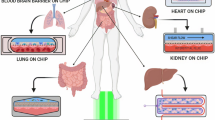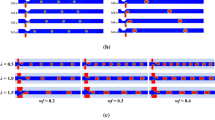Abstract
This paper presents a novel method of optimizing particle-suspended microfluidic channels using genetic algorithms (GAs). The GAs can be used to generate an optimal microchannel design by varying its geometrical parameters. A heuristic simulation can be useful for simulating the emergent behaviors of particles resulting from their interaction with a virtual microchannel environment. At the same time, fitness evaluation enables us to direct evolutions towards an optimized microchannel design. Specifically, this technique can be used to demonstrate its feasibility by optimizing one commercialized product for clinical applications such as the microchannel-type imaging flow cytometry of human erythrocytes. The resulting channel design can also be fabricated and then compared to its counterpart. This result implies that this approach can be potentially beneficial for developing a complex microchannel design in a controlled manner.
Similar content being viewed by others
References
D. Figeys and D. Pinto, Lab-on-a-chip: a revolution in biological and medical sciences, Anal. Chem. 72 (2000) 330A–335A.
G. Taubes, Computer design meets Darwin, Science, 277 (1997) 1931–1932.
T. H. Won, G. H. Hwang et al, Design of FLC for high-angle-of-attack flight using adaptive evolutionary algorithm, KSME International Journal, 17(2) (2003) 187–196.
Y. M. Kong, S. H. Choi et al, Development of integrated evolutionary optimization algorithm and its application to optimum design of ship structures, Journal of Mechanical Science and Technology, 22 (2008) 1313–1322.
Y. K. Ahn and Y. C. Kim et al, Optimal design of a squeeze film damper using an enhanced genetic algorithm, KSME International Journal, 17(12) (2003) 1938–1948.
J. Park and S. Song, Optimization of a composite laminated structure by network-based genetic algorithm, KSME International Journal, 16(8) (2002) 1033–1038.
R. J. Hartfield, J. E. Burkhalter et al, Scramjet missile design using genetic algorithms, Applied Mathematics and Computation, 174 (2006) 1539–1563.
E. Keedwell and S.-T. Khu, A hybrid genetic algorithm for the design of water distribution networks, Eng. Applications of Artificial Intelligence, 18 (2005) 461–472.
D. C. van Leijenhorst, C. B. Lucasius et al, Optical design with the aid of a genetic algorithm, BioSystems, 37(3) (1996) 177–187.
E. Salajegheh and S. Gholizadeh, Optimum design of structures by an improved genetic algorithm and neural networks, Adv. In Eng. Software, 36 (2005) 757–767.
V. Kradinov, E. Madenci et al, Application of genetic algorithm for optimum design of bolted composite lap joints, Composite Structures, 77(2) (2007) 148–159.
C. Darwin, The Origin of Species, New American Library (1859).
D. E. Goldberg, Genetic Algorithms in Search, Optimization, and Machine Learning, Addison-Wesley, USA, (1989).
J. H. Holland, Adaptation in Natural and Artificial Systems, University of Michigan Press, Ann Arbor, USA (1975).
C. W. Reynolds, Flocks, Herds, and Schools: A Distributed Behavioral Model, Computer Graphics, 21(4) (1987) 25–34.
J. Wietzorrek, N. Plesnilal et al, A new multiparameter flow cytometer: optical and electrical cell analysis in combination with video microscopy in flow, Cytometry, 35 (1999) 291–301.
F. Kubota, Analysis of red cell and platelet morphology using an imaging-combined flow cytometers, Clin. Lab. Haem., 25(2) (2003) 71–76.
J. Park, S. Chung et al, Asymmetric nozzle structure for particles converging into a highly confined region, Current Applied Physics, 6 (2006) 992–995.
K. Sims, Evolving Virtual Creatures, Computer Graphics (SIGGRAPH’94) Annual Conference Proceedings, (1994) 43–50.
H. Bang, S. H. Lim et al, Serial dilution microchip for cytotoxicity test, J. Micromech. Microeng., 14 (2004) 1165–1170.
M. E. Staben and R. H. Davis, Particle transport in Poiseuille flow in narrow channels, Int’l J. Multiphase Flow, 31(5) (2005) 529–547.
H. N. Unni and C. Yang, Brownian dynamics simulation and experimental study of colloidal particle deposition in a microchannel flow, J. Colloid and Interface Science, 291 (2005) 28–36.
X. Xuan, S. Raghibizadeh et al, Wall effects on electrophoretic motion of spherical polystyrene particles in a rectangular poly (dimethylsiloxane) microchannel, J. Colloid and Interface Science, 296(2) (2006) 743–748.
B. Fry, Ph. D. dissertation, MIT, 2005.
C. Reas, M. S. thesis, MIT, 1996.
O. K. Lim, K. S. Hong et al, Initial Design Domain Reset Method for Genetic Algorithm with Parallel Processing, KSME International Journal, 18(7) (2004) 1121–1130.
J. K. Kim, H. Bang et al, Single-cell manipulation and fluorescence detection in benchtop flow cytometry system with disposable plastic microfluidic chip, Proceedings of SPIE (The International Society for Optical Engineering), 4982 (2003) 8–20.
S. Wolfram, Cellular Automata and Complexity: Collected Papers, Westview Press, (1994).
H. A. Stone, A. D. Stroock and A. Ajdari, Engineering flows in small devices: Microfluidics towards a lab-on-a-chip, Annu. Rev. Fluid Mech., 36 (2004) 381–411.
Author information
Authors and Affiliations
Corresponding author
Additional information
This paper was recommended for publication in revised form by Associate Editor Hong Hee Yoo
Hyunwoo Bang was born in Korea on June 2, 1978. He received the B.S. degree in mechanical and aerospace engineering from Seoul National University, Seoul, Korea in 2001 and the Ph.D. degree in mechanical and aerospace engineering from Seoul National University in 2007. He did postdoctoral research at University of California Los Angeles, CA that involved the integration of functional biological components into engineered devices with Prof. Jacob J. Schmidt from April 2007 to August 2008. His current research interests include microfluidics based Lab-on-a-chip devices and their design optimization using artificial intelligence.
Dong-Chul Han received the B.S. degree from the Department of Mechanical Engineering, Seoul National University, Seoul, Korea, in 1969, and the Dipl.-Ing. and Dr.-Ing. degrees from the Department of Mechanical Engineering, University of Karlsruhe, Karlsruhe, Germany, in 1975 and 1979, respectively. He also received the Habilitation from the Department of Mechanical Engineering, University of Karlsruhe. He had been a professor in the school of Mechanical and Aerospace Engineering at Seoul National University from 1982 to 2008. His research interests include active magnetic bearing systems, mechanical lubrication, Bio-MEMS (MicroElectroMechanical Systems) and nano-fabrication.
Rights and permissions
About this article
Cite this article
Bang, H., Lee, W.G., Park, J. et al. Optimal microchannel design using genetic algorithms. J Mech Sci Technol 23, 1500–1507 (2009). https://doi.org/10.1007/s12206-009-0403-7
Received:
Revised:
Accepted:
Published:
Issue Date:
DOI: https://doi.org/10.1007/s12206-009-0403-7




